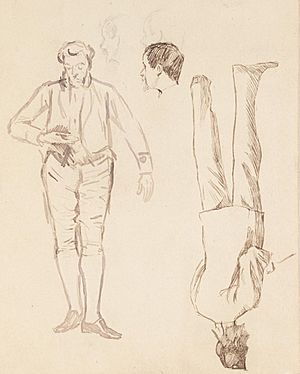Horace Harral facts for kids
Horace Downey Harral (born 1817 – died 1905) was a talented British artist. He was known for making wood engravings, etchings, and photographs. He learned his skills from a master engraver named John Orrin Smith. Later, Harral even became Smith's business partner.
Harral created prints of many beautiful Pre-Raphaelite paintings. He also illustrated many popular British magazines during the Victorian era. One of his most famous works is an engraving of Robert Howlett's photograph of Isambard Kingdom Brunel. This picture, showing Brunel in front of his giant ship, is one of the most famous photos from the 1800s. Harral also took his own photos, often posing his friends in fun, theatrical ways. He was a friend and business partner of William Luson Thomas, who started the famous newspaper The Graphic. Horace Harral became very wealthy and left most of his money to help charities.
Contents
Horace Harral's Artistic Journey
Horace Downey Harral was born in 1817 in a town called Ipswich. He started his artistic training as a student of John Orrin Smith, a well-known wood-engraver. His first known prints were made around 1844. In 1849, Harral joined Smith as a business partner. Horace also had a brother, Alfred Harral, who was an engraver too.
In 1852, Harral shared an office with William Luson Thomas. Thomas later became famous for starting The Graphic newspaper. Harral's partnership with Smith likely ended in 1854.
Engraving Famous Art
From the 1850s to the 1880s, Harral made engravings of many Pre-Raphaelite paintings. These artists were known for their detailed and colorful works. Harral was also very busy creating engravings for popular magazines. These included London Society and the Illustrated London News.
One of his most important engravings was of Robert Howlett's photograph of Isambard Kingdom Brunel. This engraving was published in the Illustrated Times on January 16, 1858. People have called this work "one of the most famous photographs of the nineteenth century." Harral also showed his own art at the Royal Academy several times. For a while, he even worked with another engraver named William James Linton.
Harral's Photography and Etchings
Besides engraving, Harral also took photographs. In the 1860s, he created a series of photos of his friends. These pictures were special because his friends were posed in very dramatic, "theatrical" ways. The National Portrait Gallery, London has said these photos were "distinguished by their technical assurance and theatrical air."
Harral also made etchings. He was good friends with the artist Charles Keene. Harral mentioned that Keene was very interested in etching and often tried new things with it. Harral continued to create artistic works until 1891.
What People Thought of His Work
Some people had different opinions about Harral's engraving work. For example, a writer named Simon Shaw-Miller said in his 2017 book that Harral was "not among the period's most sensitive engravers." His engraving of John Tenniel's "Alice's White Knight" was described as "a rather heavy-handed, dull version." Also, his engravings for Mary Ellen Edwards's work in The Claverings were called "inadequate" by some. This shows that even skilled artists can receive different kinds of feedback on their work.
Harral's Later Life and Legacy
In his later years, Horace Harral lived in a place called Chobham Cottage in Chobham, Surrey. He passed away on January 23, 1905, while visiting Hastings in Sussex.
Harral had become a very important shareholder in William Luson Thomas's company, H. R. Baines & Co. This company published The Graphic newspaper. When Harral died, his estate was worth a large sum of money, about £54,856 (which would be worth much more today).
Horace Harral was a very generous person. In his will, he left large donations to many different charities. He gave £500 to several organizations, including:
- The East Suffolk and Ipswich Hospital
- The East London Hospital for Children
- The Hospital for Sick Children
- The Artists' General Benevolent Institution (which helps artists)
- The Gordon Memorial College in Sudan
- The Royal Normal College and Academy of Music for the Blind
- Dr Barnardo's Homes (which helps children)
- The Royal National Lifeboat Institution (RNLI), which saves lives at sea
- The Free Cancer Hospital
- The Royal Association in Aid of the Deaf and Dumb
He also gave £200 each to the Royal Humane Society and the Temporary Home for Lost and Starving Dogs. In total, he gave away £6,400 to charities. He instructed his trustees to give the rest of his estate to other charities of their choice, showing his strong commitment to helping others.



